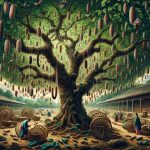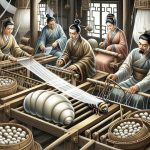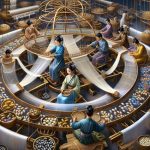If you want to know when silk fabric was invented in China, it started over 4,000 years ago during ancient times. You’ll find that skilled artisans developed sericulture—raising silkworms and weaving threads—beginning in the Neolithic period, with the Yellow Emperor often credited for introducing the craft. Silk quickly became a symbol of wealth and culture, evolving through dynasties like the Shang. Keep exploring, and you’ll uncover how silk influenced trade, technology, and society over centuries.
Table of Contents
Key Takeaways
- Silk production in China began during the Neolithic period, with early silk fragments found in ancient burial sites.
- The Yellow Emperor is traditionally credited with inventing silk production, symbolizing its cultural origin.
- Silk weaving techniques and sericulture developed gradually, reaching significant advancement by the Shang Dynasty.
- Ancient Chinese farmers innovated silkworm cultivation and mulberry tree care for sustainable silk production.
- The invention of silk fabric evolved over centuries, becoming a major economic and cultural symbol by early Chinese dynasties.
The Origins of Silk Production in Ancient China
Although silk production dates back thousands of years, it first began in ancient China, where skilled artisans discovered how to cultivate silkworms and weave their delicate threads into fabric.
Silk production originated in ancient China, where artisans perfected cultivating silkworms and weaving their delicate threads.
You’ll find that these early Chinese silk makers mastered the complex process of raising silkworms on mulberry leaves, carefully harvesting the cocoons, and unraveling fine threads.
This craftsmanship wasn’t just a trade; it became a symbol of cultural sophistication and economic power.
When you learn about the origins of silk, you’ll see how it quickly grew from a local craft to an essential commodity, sparking trade routes and influencing fashion worldwide.
Understanding this ancient skill helps you appreciate how silk remains a treasured fabric even today.
The Role of the Yellow Emperor in Silk Invention
You might be surprised to learn that the Yellow Emperor is often credited with inventing silk production in ancient China.
While stories celebrate his role, it’s important to separate myth from historical fact.
Let’s explore what his true contribution might’ve been.
Yellow Emperor’s Contribution
Legend credits the Yellow Emperor with pioneering silk production, marking a turning point in Chinese history.
If you look into ancient texts, you’ll find that he’s often portrayed as the visionary who discovered how to raise silkworms and weave their threads into fabric.
His contribution isn’t just a tale; it symbolizes the birth of an essential craft that shaped Chinese culture and economy.
When you consider the impact of silk, you realize how this innovation boosted trade and set China apart.
You can see his influence in the way silk became a symbol of sophistication and power.
Myth vs. Historical Fact
The story of the Yellow Emperor’s role in silk production has fascinated people for centuries, blending history with myth. You might assume he single-handedly invented silk, but the truth is more nuanced.
Historical evidence points to gradual development rather than one person’s discovery. When you separate fact from fiction, consider these points:
- The Yellow Emperor is a symbolic figure representing early Chinese civilization, not a verified inventor.
- Archaeological finds show silk use predates the era attributed to him by several centuries.
- Myths credit him to emphasize silk’s cultural importance rather than document actual invention.
Archaeological Evidence of Early Silk Use
You’ll find Neolithic silk fragments that reveal how early people worked with this delicate material.
Ancient sericulture tools show the sophistication behind silk production long ago.
Exploring early silk textile sites helps you understand how this craft evolved over time.
Neolithic Silk Fragments
Fragments of silk dating back to the Neolithic period provide some of the earliest archaeological evidence of silk use in China.
When you examine these silk remnants, you’ll notice they reveal the beginnings of textile craftsmanship long before recorded history. These tiny threads tell you that ancient people valued silk for its softness and durability.
Here’s what you should know about these fragments:
- Found in burial sites, indicating silk’s cultural and ritual significance
- Preserved in favorable conditions like dry caves, helping you study their weave patterns
- Often mixed with other fibers, showing early experimentation with fabric blends
Ancient Sericulture Tools
Silk remnants from Neolithic sites hint at an early appreciation for this delicate fabric, but understanding how ancient people produced silk requires examining the tools they used.
You’ll find that archaeologists have uncovered pottery spindles, bone needles, and loom parts near silk discovery sites, all pointing to an organized sericulture process. These tools helped ancient Chinese efficiently reel silk threads from cocoons, spin them into yarn, and weave fine fabric.
You can also see evidence of small clay trays used to boil cocoons, making the silk easier to unwind. By studying these artifacts, you get a glimpse into the skill and innovation involved in early silk production, revealing how the Chinese mastered sericulture long before it spread beyond their borders.
Early Silk Textile Sites
Although ancient tools reveal how silk was made, the locations where these textiles were found offer essential insights into their early use.
When you explore these archaeological sites, you uncover more than just remnants; you glimpse the cultural and economic significance of silk in ancient China.
Key sites include:
- Jiahu Village: Early evidence of silk threads dating back over 7,000 years suggests primitive sericulture.
- Mawangdui Tombs: Well-preserved silk garments reveal advanced weaving techniques from the Western Han Dynasty.
- Liangzhu Culture Sites: Silk fragments here indicate the material’s role in ritual and status symbols.
The Development of Sericulture Techniques
As you explore the origins of sericulture, you’ll find that ancient Chinese farmers developed innovative techniques to cultivate silkworms and harvest their precious fibers.
Ancient Chinese farmers pioneered sericulture with innovative methods to nurture silkworms and harvest their silk fibers.
They carefully nurtured mulberry trees, the silkworms’ primary food source, ensuring a steady supply of leaves. You’d learn that farmers controlled temperature and humidity to optimize silkworm growth and cocoon quality.
They mastered the timing of harvesting cocoons to extract silk threads without damaging them. You’d also discover early methods of reeling silk, where workers unwound fine filaments from each cocoon.
These advancements allowed silk production to become more efficient and consistent. By refining these sericulture techniques, the Chinese laid a foundation that supported silk’s rise as a treasured fabric, long before it spread beyond their borders.
Silk Fabric in the Shang Dynasty
You’ll find that silk production during the Shang Dynasty marked a significant step in early Chinese textile history.
The techniques they used laid the groundwork for more advanced sericulture later on.
Exploring these textiles reveals how important silk was to their culture and economy.
Early Silk Production
When exploring the roots of silk production in China, the Shang Dynasty stands out as a pivotal era. During this time, you’d witness the early techniques that shaped silk fabric’s future.
You’d see how sericulture became more organized, with farmers cultivating mulberry trees to feed silkworms carefully. The Shang Dynasty’s advancements helped establish silk as a valuable material, both for clothing and ritual use.
Key aspects include:
- The development of reeling methods to extract fine silk threads efficiently
- The use of primitive looms enabling basic weaving patterns
- The strategic role of silk in trade and as a symbol of status
These early innovations laid the groundwork for silk’s enduring cultural and economic significance in China.
Shang Dynasty Textiles
Although silk production dates back earlier, the Shang Dynasty truly refined the art of creating textiles that combined durability with elegance.
When you examine Shang Dynasty textiles, you notice their intricate weaving techniques and use of high-quality silk fibers that set them apart from previous eras. They didn’t just produce fabric; they crafted materials that symbolized status and power.
You’d find silk used in garments for nobility and ceremonial purposes, reflecting the dynasty’s social hierarchy. The Shang also developed dyeing methods, adding vibrant colors to silk that enhanced its visual appeal.
The Impact of Silk on Chinese Society
Because silk was both a luxury item and a symbol of status, it shaped many aspects of Chinese society. You’d notice that silk wasn’t just fabric; it influenced culture, social hierarchy, and even fashion. When you wore silk, you communicated wealth and power without saying a word. It also played a role in rituals and ceremonies, highlighting its deep cultural significance.
Consider how silk impacted your daily life:
- It distinguished social classes, as only elites wore pure silk garments.
- It influenced art and literature, inspiring motifs and themes.
- It reinforced diplomatic relationships through silk gifts among nobility.
Understanding silk’s societal impact helps you appreciate why it remained treasured throughout Chinese history.
Silk’s Role in Ancient Chinese Economy
Since silk was highly prized both within China and abroad, it became a cornerstone of the ancient Chinese economy. You’d find silk production tightly controlled by the state, ensuring quality and exclusivity.
The industry provided jobs for countless artisans, farmers, and traders, stimulating economic growth in rural and urban areas alike. As you explore ancient markets, you’d notice silk wasn’t just a luxury fabric but also a valuable commodity used as currency or tribute.
This demand encouraged advancements in sericulture techniques, boosting efficiency and output. By managing silk production and trade, the government secured significant revenue, which funded infrastructure and military efforts.
The Silk Road and Global Trade Expansion
When you trace the routes of ancient trade, the Silk Road stands out as a vital network connecting China with distant lands.
This extensive trade route allowed silk fabric to reach far beyond China, influencing economies and cultures across Asia, the Middle East, and Europe.
As you explore its impact, consider how the Silk Road:
- Facilitated cultural exchanges, spreading ideas, religions, and technologies alongside silk.
- Enabled China to establish diplomatic relations with various empires through trade.
- Boosted local economies by creating demand for not only silk but also spices, precious metals, and artworks.
Technological Advances in Silk Weaving
Several key technological advances transformed silk weaving in China, making the craft more efficient and intricate than ever before.
You’d see innovations like the introduction of the foot-powered loom, which freed weavers’ hands and sped up production.
Later, the drawloom allowed you to create complex patterns by controlling individual warp threads, opening new artistic possibilities.
You’d also notice improvements in dyeing techniques, which made colors more vibrant and long-lasting on silk fabric.
These advances didn’t just enhance the quality; they enabled larger-scale production to meet growing demand.
As you explore these developments, you’ll appreciate how they laid the groundwork for silk’s enduring reputation as a luxurious and finely crafted fabric.
These technological strides truly revolutionized silk weaving in ancient China.
Cultural Significance of Silk in Imperial China
The technological advances in silk weaving didn’t just boost production—they also elevated silk’s status in Imperial China.
When you wore silk, you weren’t just displaying fashion; you were showcasing power, wealth, and divine favor. Silk was deeply tied to the imperial identity, symbolizing authority and prestige.
Here’s why silk mattered culturally:
- It was reserved for royalty and high officials, marking social hierarchy.
- Silk appeared in important rituals and ceremonies, connecting the earthly to the spiritual.
- The intricate patterns woven into silk conveyed symbolic meanings, such as longevity and prosperity.
The Spread of Silk Production Beyond China
Although silk originated in China, its production techniques didn’t stay confined there for long. You might be surprised to learn how quickly silk-making spread beyond Chinese borders.
Traders along the Silk Road carried not just finished silk but also knowledge of sericulture to Central Asia and beyond. By the 6th century, monks smuggled silkworm eggs and mulberry seeds into the Byzantine Empire, jumpstarting silk production in Europe.
As you explore this history, you’ll see how silk became a symbol of luxury worldwide, influencing economies and cultures far from its origin.
Modern Perspectives on Ancient Silk Craftsmanship
As silk spread across continents, its ancient craftsmanship evolved but never lost its charm.
Silk’s timeless allure endures, weaving ancient artistry into the fabric of modern creativity.
When you explore modern perspectives on this timeless fabric, you’ll appreciate how artisans blend tradition with innovation.
You’ll notice that today’s silk work:
- Honors ancient techniques, preserving hand-weaving and natural dyeing methods.
- Integrates contemporary designs, appealing to modern fashion and interior trends.
- Employs sustainable practices, reflecting growing environmental awareness.
Frequently Asked Questions
How Is Silk Fabric Maintained and Cleaned Today?
You should hand wash silk with cold water and mild detergent, avoid wringing, and air dry it away from direct sunlight. For stubborn stains, consider professional dry cleaning to keep your silk fabric looking pristine.
What Are the Main Differences Between Silk and Synthetic Fabrics?
Imagine wearing a gentle whisper against your skin—that’s silk, natural and breathable. Synthetic fabrics, like plastic cousins, trap heat and moisture. You’ll notice silk’s shimmer and softness, while synthetics often feel rougher and less luxurious.
Can Silk Fabric Cause Allergies or Skin Irritation?
Silk fabric rarely causes allergies because it’s natural and hypoallergenic. But if you have sensitive skin or allergies to sericin, the silk protein, you might experience irritation. Always test new fabrics before full use.
What Environmental Impacts Does Modern Silk Production Have?
You’ll find modern silk production uses significant water and energy, sometimes involving pesticides that harm ecosystems. Choosing sustainably sourced silk can help reduce these environmental impacts and support more eco-friendly practices in the industry.
How Is Silk Used in Contemporary Fashion Design?
You’ll find silk used in contemporary fashion for luxurious dresses, blouses, scarves, and ties. Designers love its smooth texture and sheen, often blending it with other fabrics to create elegant, breathable, and stylish garments.
- Does Chiffon Fabric Stink - July 15, 2025
- Does Chiffon Fabric Affect the Economy - July 15, 2025
- Does Cotton Fabric Have a Nap - July 15, 2025







